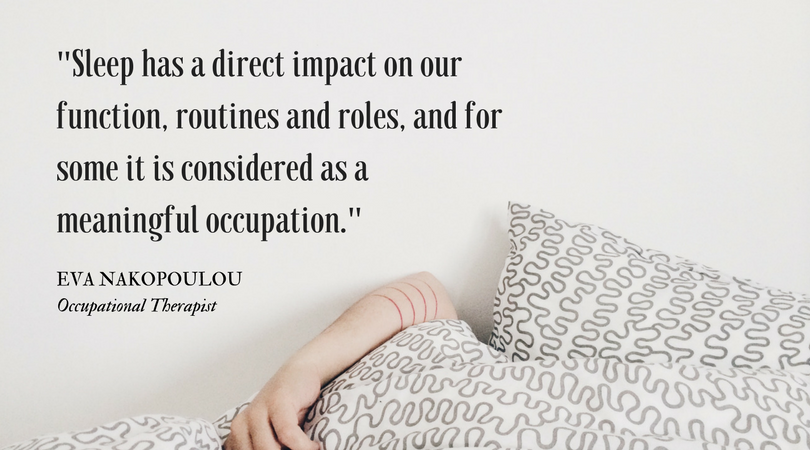Eva talks about her contribution to “The Occupational Therapist’s Guide to Sleep and Sleep Problems” and her interest in “sleep” as a vital domain in OT.
“Edward Norton playing the narrator in Fight Club says: ‘When you have insomnia, you’re never really asleep…and you’re never really awake’ and look where his insomnia got him! Hollywood aside, we all have experienced at least one night’s bad sleep (or no sleep at all) and the affect it had on our daily lives.
Sleep has a direct impact on our function, routines and roles, and for some it is considered as a meaningful occupation. Therefore it comes as no surprise that sleep and rest were added as domains of occupation in the 2008 version of the American Occupational Therapy Association (AOTA) Occupational Therapy Practice Framework (AOTA, 2008).
At the same time in U.K. came Green’s (2008) article, where he was advocating that sleep is fundamental in sustaining occupational balance and thus as occupational therapists we should be asking our clients about their sleep and explore whether Occupational Therapy can form part of the solution to their sleep problems. And the solution, or intervention for many sleep problems can often be found in the levels of activity during the day and the living and sleeping environment, both of which lay within the remit of Occupational Therapy.
Not long after, I published an article with Sophie Cullen (2012) on our experience as final year students on a role emerging placement in a primary healthcare centre of a Category B Male Adult prison. There we worked on scoping out the potential for occupational therapy and we set up a sleep group for prisoners who suffered from sleep deprivation. Andrew Green read this and we eventually met on a workshop he was delivering and decided to collaborate in the book An Occupational Therapist’s Guide to Sleep and Sleep Problems published in February 2015.
Andrew had the sleep expertise and I along with Emma and Megan (co-authors) had the learning disabilities expertise – a match was made. And this is how most of the book has been written, a collaboration between the editors, who are occupational therapy sleep experts and specialist occupational therapists working in a variety of areas including mental health, chronic fatigue syndrome, paediatrics, dementia and the list goes on. I may be a bit biased about the book when I think it is a good Occupational Therapy book, but what I am certain of, is that I really enjoyed the process and I learned a lot through my contributions.”
References:
American Occupational Therapy Association. (2008) Occupational therapy practice framework: Domain and process (2nd ed). American Journal of Occupational Therapy. 62(6), pp.625–683.
Green, A. (2008) Sleep, Occupation and the Passage of Time. British Journal of Occupational Therapy. 71(8), pp. 339-347.Green, A. and Brown, C. (eds) (2015) An Occupational Therapist’s Guide to Sleep and Sleep Problems. London: Jessica Kingsley Publishers.
Nakopoulou, E. and Cullen, S. (2012) Our time in prison. OT News. 20(4), pp.30-31.


